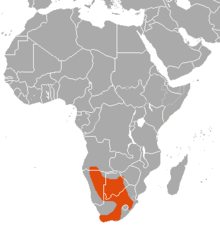Red Hartebeest
| Red hartebeest | |
|---|---|
 |
|
| At Etosha National Park, Namibia | |
| Scientific classification | |
| Kingdom: | Animalia |
| Phylum: | Chordata |
| Class: | Mammalia |
| Order: | Artiodactyla |
| Family: | Bovidae |
| Subfamily: | Alcelaphinae |
| Genus: | Alcelaphus |
| Species: | A. buselaphus |
| Subspecies: | A. b. caama |
| Trinomial name | |
|
Alcelaphus buselaphus caama Geoffroy Saint-Hilaire, 1803 |
|
 |
|
| Distribution of red hartebeest (in orange) | |
| Synonyms | |
|
Alcelaphus buselaphus caama G. Cuvier, 1804 |
|
Alcelaphus buselaphus caama G. Cuvier, 1804
The red hartebeest (Alcelaphus buselaphus caama or A. caama) is a species of even-toed ungulate in the family Bovidae found in Southern Africa. More than 130,000 individuals live in the wild. The red hartebeest is closely related to the tsessebe and the topi.
Alcelaphus buselaphus caama is a large African antelope of the family Bovidae, one of ten subspecies; it is sometimes treated as a separate species, A. caama. Commonly known as the red hartebeest, it is the most colorful hartbeest, with black markings contrasting against its white abdomen and behind. It has a longer face that other subspecies, with complex curving horns joined at the base. The average weight of a male is about 150 kg, and female is 120 kg. Their average shoulder height is 135 cm, and horns are 60 cm long. The life expectancy of a red hartebeest is around 19 years. Little sexual dimorphism is noted between males and females, showing no distinct identifiable physical features, but body size is slightly affected. Horn size, however, expresses more dimorphism between males and females, as males fight and defend themselves for sexual selection. Thus, male skull weight and circumference is slightly greater than that of the female. Hartebeests have an excellent sense of hearing and smell, although their sense of sight is poor. When alarmed, hartebeests elude confusion before running, by which they can reach a maximum speed of 55 km/h. Their evasion tactic is to run in a zigzag pattern, making it difficult for predators to catch them.
A. buselaphus subspecies have a gestation period of eight months, and they give birth to single calves. They typically give birth in a seasonal pattern before the summer rain begins. After birth, calves are hidden in dense vegetation before joining a group to increase their chances of survival from predators, since they are weak. Most females begin breeding after the age of two, and can conceive again 9 or 10 months after giving birth.
Red hartebeests are grass feeders, which is evidenced by their long snouts, which give the advantage of an improved cropping ability to acquire and masticate grasses more efficiently. During the rainy season in southern Africa, the grass species Andropogon is in abundance and is the main source of dietary consumption. As grazers, their diets fluctuate seasonally, as they consume higher-quality, green primary production in wet seasons, and lower-quality sheath material in the dry seasons. Hartebeests are considered less water-dependent than most alcelaphines, only needing to drink water when melons and tubers are inaccessible.
...
Wikipedia

